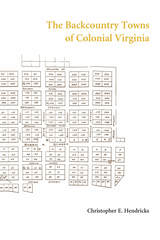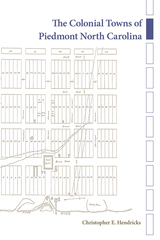

How do towns come into existence? What circumstances determine whether they succeed or fail? In The Colonial Towns of Piedmont North Carolina, author Christopher E. Hendricks looks at one region in eighteenth-century America to explore answers to these questions. He examines the establishment and development of eleven towns in the Piedmont, classifying them into three types: county towns formed by the establishment of government institutions, such as a courthouse; trade towns formed around commercial opportunities; and religious towns such as the three towns developed in Wachovia, a region where Moravians settled. He uses these classifications to tell the stories of how these towns came into being, and how, in their development, they struggled against economic, cultural, and political challenges.
Ultimately, The Colonial Towns of Piedmont North Carolina deepens our understanding of the influence that American towns had on the settlement of the backcountry. Hendricks tells the poignant story of the Moravians’ struggle to maintain their neutral stance during the Revolutionary War, surviving exploitation and brutality from both the Continental Army and the British. The author also integrates the history of Native Americans into this mix of competing forces and shows how they were challenged by—and resisted—the newcomers. He emphasizes the role of individual initiative as well as the impetus of government, specifically courthouses, in establishing towns. By utilizing a variety of rarely examined primary sources, methodological approaches ranging from geographic theory to material culture studies, and a deep examination of local history, Hendricks provides a comprehensive analysis of the emergence of these towns on the frontier.
READERS
Browse our collection.
PUBLISHERS
See BiblioVault's publisher services.
STUDENT SERVICES
Files for college accessibility offices.
UChicago Accessibility Resources
home | accessibility | search | about | contact us
BiblioVault ® 2001 - 2024
The University of Chicago Press









